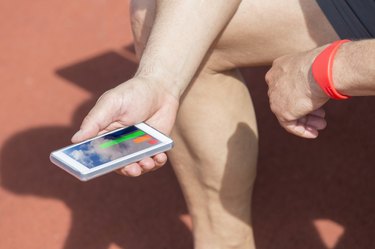
Blood pressure levels are one measurement used in conjunction with other signs and symptoms to evaluate a patient. In some situations, such as a motor vehicle accident or if an injury site is close to active machinery, noise levels may be high enough to interfere with measuring blood pressure with a stethoscope. An alternative method is to measure blood pressure by touch or palpation. This method is not as accurate as auscultation (using a stethoscope to listen for the pulse sounds), but can be helpful in emergencies.
Step 1
Wrap the blood pressure cuff securely (but not too tightly) around the upper arm of the patient. Position the cuff so that it is approximately 1 inch above the elbow and center the bladder (the part that fills with air) over the brachial artery.
Video of the Day
Step 2
Locate the radial pulse on the arm bearing the blood pressure cuff. If possible, turn the patient's hand so that the palm is facing up. Place three fingers in the middle of the patient's wrist (do not use your thumb). Slide your fingers toward the thumb-side of the wrist and apply moderate pressure until you can feel the pulse beats.
Step 3
Confirm that the valve on the pressure gauge is closed and begin pumping the bulb to inflate the cuff. Continue pumping until you can no longer feel a pulse, note where the needle on the gauge is located and inflate the cuff an additional 20 mmHg (millimeter of mercury is the unit of measure on the blood pressure gauge).
Step 4
Slowly deflate the cuff by opening the valve and releasing air from the bladder. Notice the reading on the gauge when you are once again able to feel the radial pulse. This is the patient's systolic pressure.
Step 5
Record the reading, the time of the reading and remove the blood pressure cuff.
Tip
If you are unsure of the reading, wait a few minutes before reapplying the blood pressure cuff or use the other arm to perform the test.
Warning
A thumb has a pulse and may cause you to read your own pulse rather than the patient's.
Video of the Day
Is this an emergency? If you are experiencing serious medical symptoms, please see the National Library of Medicine’s list of signs you need emergency medical attention or call 911.